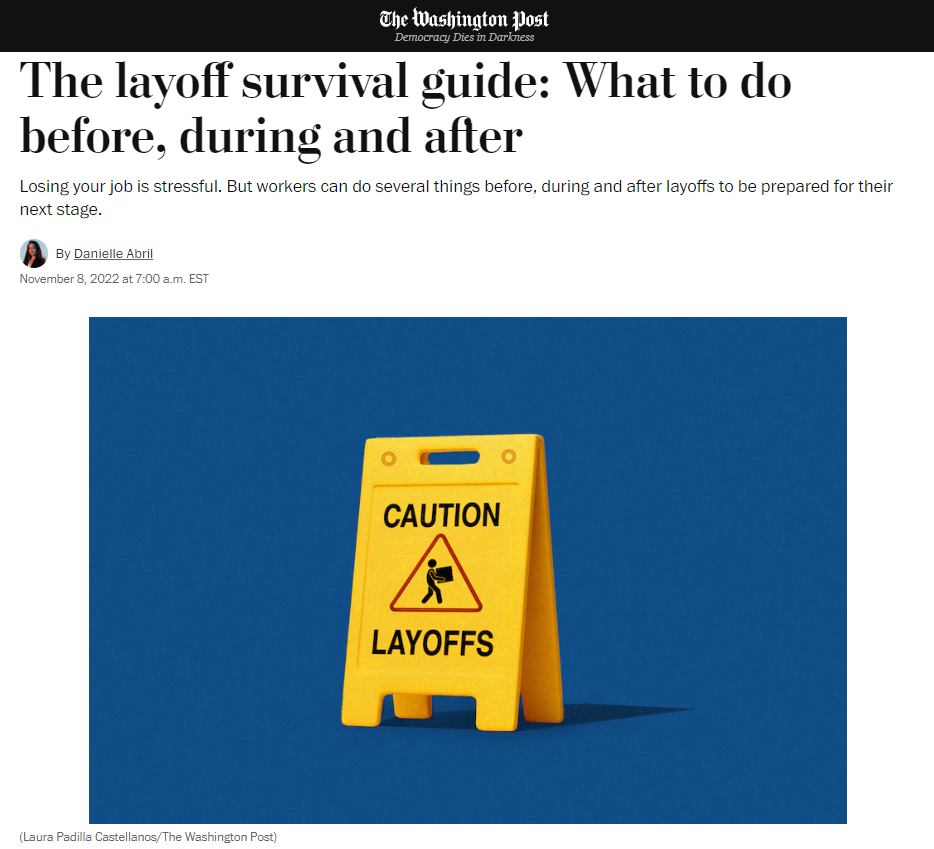Crawford Thomas Recruiting, President, William Stonehouse III was featured as an expert in the Washington Post article that covered the sensitive topic of layoffs. This helpful guide to navigating layoffs, has some sound advice for before during and after a possible layoff occurs.
Washington Post Article here.

Losing your job is stressful. But workers can do several things before, during and after layoffs to be prepared for their next stage.
Thousands of tech employees were laid off last week from companies including Twitter, Lyft, Stripe and dozens of venture-backed start-ups. As the economy continues to pressure companies’ bottom lines, experts say, more layoffs could be coming.
“We’re going to see it start affecting other industries,” said John Anderson, a managing director of executive search firm Allegis Partners. “We’re going to need to brace ourselves for a slowdown across the board.”
While losing a job can be jarring, here are eight things workers should keep in mind if they think their jobs could be on the chopping block.
Before you get laid off
Get organized: The minute you get wind of a possible layoff, start readying your finances, medical needs and personal belongings.
If possible, cut back spending and save up three to six months of living expenses, said Christopher Kayes, the department of management chair at the George Washington University School of Business. Familiarize yourself with your state’s unemployment laws and federal rules on notification.
Understand your benefits, said Diana Brown, the head of people for fintech company Eco. If you have a flexible spending account, you may want to use funds before losing them in a layoff, she added. Make any health and dental appointments to use your coverage while you can.
Workers also might want to take home valuable personal items as they may not have access to the office after layoffs, Kayes said. That includes digital address books, correspondence or items workers may want to use for their portfolios, said Juliana Schroeder, an associate professor at the University of California at Berkeley’s Haas School of Business. But be cautious: You could be in legal trouble if you take assets belonging to the company.
Stay connected: Keep your résumé, professional profile and connections up to date, experts agree.
“That’s a great thing to do on a rainy day in general,” said William Stonehouse, the president and co-founder of recruiting firm Crawford Thomas. “If a bomb were to go off, you can immediately apply.”
Stonehouse also recommends workers join relevant job groups on social networks, and Schroeder suggests connecting withcolleagues who may be affected by the layoffs. (Remember to keep conversations off company-owned services such as email and chats.) This can help create a support system for sharing resources, Schroeder said.
“You might find some people are already banding together,” she said.
Network and apply: Connections often turn into jobs, Stonehouse said. So start conversations with people in your network who are employed by or know people at potential future employers. But do not make it public that you are looking for a job, he added.
Act as though you are always on the market, constantly considering backups, Schroeder said. If laid off, you can jump on known opportunities. Apply to new jobs before you’re unemployed, Kayes said.
“It’s going to take weeks or months to get hired,” he said. “You want to get a head start.”
When you get laid off
Take care of business: Obtain and read through all layoff documents, experts say. That includes getting details like your last day and any other terms of the separation.
Ask your employer about health care, whether there is a severance package and what information will be communicated to potential future employers, Kayes said. Some companies also offer counseling or access to staffing agencies, Stonehouse said. If your employer doesn’t offer outplacement support, check at local associations and community and government organizations as they may provide resources, Brown recommends.

Severance may also be negotiable — from how long workers will be paid to when their benefits end. You can note how your package compares to others in your industry, Schroeder said, adding that“it’s good to have data to back it up.”
Before signing any official documents, workers may want to seek legal advice, especially if they think the decision was retaliatory, discriminatory or violates an employment agreement, said Jeffrey Siminoff, the senior vice president of workplace dignity at the nonprofit Robert F. Kennedy Human Rights. Document everything in case a legal issue arises later, Schroeder said.
Remain calm: Don’t let emotions get the best of you, experts advise.
“A big mistake people make is they take it personally and have a poor reaction,” Stonehouse said. “They risk burning a bridge.”
Instead, remain courteous and professional. Focus on the tasks at hand, meet all deadlines, and don’t violate any policies on the way out, Siminoff said,as that may interfere with benefits or severance.
A systematic layoff shouldn’t hurt a worker’s chance of getting hired, so don’t jeopardize your future by mishandling the departure, Stonehouse said. You may run into your former supervisors and co-workers down the line.

After you get laid off
Give yourself time: Emotional recovery after losing a job may take days, weeks or even months, Kayes said, so give yourself permission and space to grieve.
“You lose a piece of your identity,” he said. “There’s an emotional toll to that.”
Anderson suggests unplugging and turning to your support network. Maintaining the same schedule you had pre-layoff can help with some of the negative psychological effects, Kayes said. Get up at the same time, get dressed, and continue with your workout routine.
Then strategize next steps, Stonehouse said. This may be a good time to consider whether you want to broaden your skills to jobs in other industries or if there’s another career you might enjoy.
“It might be an opportunity versus a crisis,” Stonehouse said.
Whatever you do, pause before posting volatile messages on social media, which may feel good in the moment but can cause problems later on, Siminoff said.
Tell others you’re job hunting: While you may have been quietly seeking other opportunities, it’s time to go public.
Stonehouse suggests using the “open to work” setting on LinkedIn, signaling to recruiters that you are in the market. You can also share your résumé on digital job boards and on social media posts. If you will still be on the company payroll for weeks or months,keep the job as your current employer on your résumé, Anderson said. You can explain your situation during an interview.
“There’s power in employment,” he said. “Talking to people as an employed person … gives additional cache.”
This is also a good time to ask former colleagues, managers or even a professional coach for help identifying your strengths and weaknesses, Brown said. You can then determine whether you need additional training.
Get back to work: If your next step is to get a new job, commit the bulk of your day to job-hunting, several experts said. You also should file for unemployment and health-care benefits if qualified.
Be open to change, Stonehouse and Kayes said. You may have skills applicable to positions you never considered.
“With more jobs being hybrid and remote, your options have expanded greatly,” Stonehouse said.

Ahead of interviews, prepare a one-minute elevator pitch articulating what you’re good at and where you can have impact, Brown said. Be prepared to discuss why you left or are leaving your company.
Andbrace yourself for rejection — lots of it, Brown said. Depending on your industry and job, economic conditions might make your search challenging.
“Sometimes it’s just an automated system [rejecting you],” she said. “Do not take it personally.”
Follow our Recruiter Blog and Social Media:

